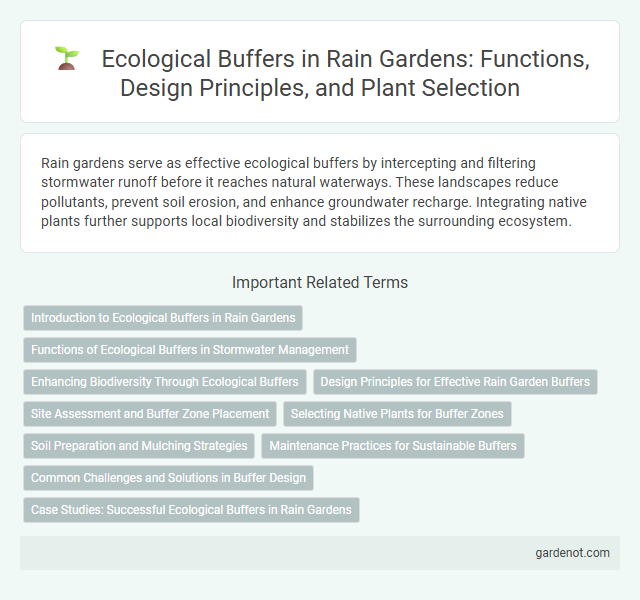Rain gardens serve as effective ecological buffers by intercepting and filtering stormwater runoff before it reaches natural waterways. These landscapes reduce pollutants, prevent soil erosion, and enhance groundwater recharge. Integrating native plants further supports local biodiversity and stabilizes the surrounding ecosystem.
Introduction to Ecological Buffers in Rain Gardens
Ecological buffers in rain gardens serve as transitional zones that filter pollutants and manage stormwater runoff, enhancing water quality and supporting local biodiversity. These buffers typically consist of native vegetation that slows water flow, promotes infiltration, and provides habitat for beneficial wildlife. The strategic use of ecological buffers reduces erosion and sedimentation, ensuring the rain garden functions as an effective natural filtration system.
Functions of Ecological Buffers in Stormwater Management
Ecological buffers in stormwater management function as natural filters that reduce pollutants by trapping sediments, nutrients, and heavy metals before runoff reaches water bodies. They enhance infiltration by slowing water flow, promoting groundwater recharge, and reducing surface runoff volume. These buffers also stabilize soil, prevent erosion, and provide habitat for wildlife, contributing to improved water quality and ecosystem health.
Enhancing Biodiversity Through Ecological Buffers
Ecological buffers in rain gardens create vital habitats that support diverse plant and animal species, significantly enhancing local biodiversity. These buffers filter pollutants, improve soil health, and regulate water flow, fostering a balanced ecosystem. Integrating native vegetation within ecological buffers strengthens resilience against invasive species and promotes sustainable wildlife corridors.
Design Principles for Effective Rain Garden Buffers
Rain garden buffers enhance water filtration and habitat quality by incorporating native vegetation with deep root systems that stabilize soil and improve infiltration. Effective design principles prioritize diverse plant species to promote biodiversity and resilience against pollutants and erosion. Proper placement ensures runoff is captured before entering waterways, maximizing ecological benefits and minimizing urban stormwater impacts.
Site Assessment and Buffer Zone Placement
Site assessment for rain garden ecological buffers involves analyzing soil composition, hydrology, and existing vegetation to determine optimal buffer zone placement that maximizes filtration of stormwater runoff and protects adjacent ecosystems. Effective buffer zones are strategically positioned to intercept pollutants, reduce erosion, and support native plant biodiversity, enhancing water quality and habitat connectivity. Detailed evaluation of slope, drainage patterns, and pollutant sources guides the design and dimensions of buffer zones to create resilient, functional landscapes.
Selecting Native Plants for Buffer Zones
Selecting native plants for ecological buffer zones in rain gardens enhances water filtration and supports local wildlife habitats. Native species such as switchgrass, blue flag iris, and black-eyed Susan thrive in the local soil and climate, reducing maintenance needs and increasing drought resistance. Incorporating diverse native plants improves the buffer's capacity to trap pollutants, manage stormwater runoff, and promote biodiversity.
Soil Preparation and Mulching Strategies
Ecological buffers in rain gardens require thorough soil preparation, including aeration and incorporation of organic matter to enhance infiltration and support diverse plant life. Applying mulch, such as shredded bark or hardwood chips, helps retain soil moisture, suppress weed growth, and regulate temperature fluctuations. Effective mulching combined with well-prepared soil promotes healthy microbial activity and prevents erosion within the buffer zone.
Maintenance Practices for Sustainable Buffers
Effective maintenance practices for ecological buffers in rain gardens include regular inspection to remove invasive species and restore native vegetation, ensuring optimal soil permeability and water filtration. Periodic mulching helps retain moisture and suppress weeds, while monitoring sediment accumulation prevents clogging and preserves the buffer's ecological function. Sustainable buffer management combines adaptive strategies with community involvement to enhance biodiversity and long-term stormwater mitigation.
Common Challenges and Solutions in Buffer Design
Ecological buffers in rain gardens often face challenges such as soil erosion, invasive species intrusion, and inadequate water retention capacity. Designing buffers with native, deep-rooted plants enhances soil stability and biodiversity while improving filtration and water absorption. Incorporating layered vegetation and proper grading addresses runoff management, ensuring buffer effectiveness in protecting aquatic ecosystems.
Case Studies: Successful Ecological Buffers in Rain Gardens
Case studies of successful ecological buffers in rain gardens demonstrate their effectiveness in filtering pollutants, enhancing biodiversity, and stabilizing soil. For instance, urban rain gardens in Portland, Oregon have significantly reduced stormwater runoff pollutants by incorporating native grasses and shrubs as ecological buffers. Similarly, a study from Minnesota revealed that rain gardens with diverse plant species improved water quality and provided habitat for pollinators, showcasing the ecological buffer's role in sustainable stormwater management.
Ecological buffer Infographic

 gardenot.com
gardenot.com